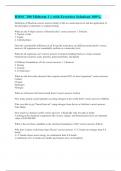Most common nucleic acids - Study guides, Class notes & Summaries
Looking for the best study guides, study notes and summaries about Most common nucleic acids? On this page you'll find 1765 study documents about Most common nucleic acids.
Page 4 out of 1.765 results
Sort by

-
BMSC 200 Midterm 1 || with Errorless Solutions 100%.
- Exam (elaborations) • 14 pages • 2024
- Available in package deal
-
- $11.49
- + learn more
Definition of Biochem correct answers Study of life at a molecular level and the application of the principles of chemistry to explain biology What are the 4 Major classes of biomolecules? correct answers 1. Proteins 2. Nucleic Acids 3. Lipids 4. Carbohydrates Does the considerable difference in all living life mean they are different molecularly? correct answers All organisms are remarkably uniform at a molecular level What do all organisms use? correct answers Common building block...

-
Biology 2420 - Final Exam (Questions & Answers) Rated 100%
- Exam (elaborations) • 46 pages • 2024
-
- $7.99
- + learn more
A form of asexual reproduction in single-celled organisms by which one cell divides into two cells of the same size - Binary Fission Enzymes, toxins, and other factors that affect the relative ability of a pathogen to infect and cause disease. - Virulence factors Gram staining differentiates bacteria based on their: A) ATP B) endospore C) cell wall D) integral proteins - Cell Wall Reactions that require energy are called ________ reactions: A) endergonic B) endothermic C) exergonic ...

-
Honors Biology Semester 1 Final Exam Questions and Answers 100% Pass
- Exam (elaborations) • 18 pages • 2024
- Available in package deal
-
- $12.49
- + learn more
Honors Biology Semester 1 Final Exam Questions and Answers 100% Pass What are the steps of the scientific method? - Answer- Observation, question, hypothesis, experiment, analysis, conclusion What are the 7 characteristics of living things? - Answer- CHEMGER: cells, homeostatis, energy, metabolism, growth, evolution, reproduction What is the difference between a molecule, atom, compound, and element? (give an example) - Answer- order in size: atom, element, molecule, compound O O H2O H2O...

-
Honors Biology Semester 1 Final Exam Questions and Answers 100% Pass
- Exam (elaborations) • 18 pages • 2024
- Available in package deal
-
- $12.49
- + learn more
Honors Biology Semester 1 Final Exam Questions and Answers 100% Pass What are the steps of the scientific method? - Answer- Observation, question, hypothesis, experiment, analysis, conclusion What are the 7 characteristics of living things? - Answer- CHEMGER: cells, homeostatis, energy, metabolism, growth, evolution, reproduction What is the difference between a molecule, atom, compound, and element? (give an example) - Answer- order in size: atom, element, molecule, compound O O H2O H2O...

-
Science Bowl Practice Questions – Biology with Complete Solutions
- Exam (elaborations) • 22 pages • 2024
- Available in package deal
-
- $9.99
- + learn more
Science Bowl Practice Questions – Biology with Complete Solutions What organelle functions to isolate a human cell's chromosomes from the cytoplasm? nucleus What is the primary oxygen-carrying protein found in red blood cells? hemoglobin How many permanent teeth does a normal adult human have? 32 How many canine teeth does a typical human adult have? 4 In the taxonomical name Homo sapiens, what taxonomical rank does sapiens represent? species Most of the heart is composed...

-
BSC1005 midterm study questions and answers solved 2024
- Exam (elaborations) • 14 pages • 2024
- Available in package deal
-
- $12.49
- + learn more
Which is the correct sequence for levels of biological organization within a multicellular organism? - atom - molecule - organelle - cell - tissue Which is the correct sequence for levels of biological organization occurring beyond an organism? - population - community - ecosystem - biosphere All living organisms - are either unicellular or multicellular If you observed a newly discovered 'thing' and tried to decide if it might be alive, what would be the weakest distinction for life?...

-
IB Biology HL exam 2024 with 100% correct answers
- Exam (elaborations) • 40 pages • 2023
- Available in package deal
-
- $16.49
- + learn more
What are the characteristics common to all forms of life? - correct answer reproduction, carbon, responds to surroundings, Growth and Development, cellular organization, and energy What are the levels of biological organization from simple to most complex? - correct answer Molecules, cell, tissue, organ, organism, population, community, ecosystem, biosphere What are the 4 most common types of biological molecules? - correct answer Proteins, nucleic acids, carbohydrates, and lipids ...

-
BIO 141 EXAM 1 STUDY QUESTIONS SOLVED CORRECTLY & GRADED A+
- Exam (elaborations) • 14 pages • 2024
- Available in package deal
-
- $7.99
- + learn more
What are the four most common elements? - Answer-Hydrogen, oxygen, carbon, nitrogen What is the difference between and atom and a molecule? - Answer-An atom is composed of subatomic particles and the smallest unit of an element A molecule is 2 or more atoms combing to form a distinctive particle What does it mean that water is polar? - Answer-There is an uneven distribution of electrical density Partial (-) charge near oxygen atom and (+) charge near hydrogen atom What are the bonds that a...

-
Bio 171 Exam 1 Questions with Complete Solutions.
- Exam (elaborations) • 8 pages • 2024
-
- $12.99
- + learn more
Bio 171 Exam 1 Questions with Complete Solutions. archaea Answer- like bacteria. Are able to live in extreme environment bacteria Answer- microorganisms that are the basis of fermentation & infectious diseases. Typically one-celled, have no chlorophyll, multiply by simple division, & can be seen only with a microscope. They occur in 3 main forms: spherical, rod-shaped, & spiral eukaryote Answer- an organism that uses aerobic cellular respiration to break down compounds including oxygen in...

-
Biology 1201 LSU Exam 2: Pomarico Latest Version Graded A+
- Exam (elaborations) • 20 pages • 2024
- Available in package deal
-
- $9.99
- + learn more
Biology 1201 LSU Exam 2: Pomarico Latest Version Graded A+ macromolecules large organic molecules which are usually polymers polymers large molecules consisting of many identical or similar subunits monomer subunit of a polymer most biological polymerization reactions are_____ condensation reactions aka dehydration synthesis reactions condensation reactions (dehydration synthesis) polymerization reactions in which the covalent linkage of the monomers is accompanies by removal...

How much did you already spend on Stuvia? Imagine there are plenty more of you out there paying for study notes, but this time YOU are the seller. Ka-ching! Discover all about earning on Stuvia


